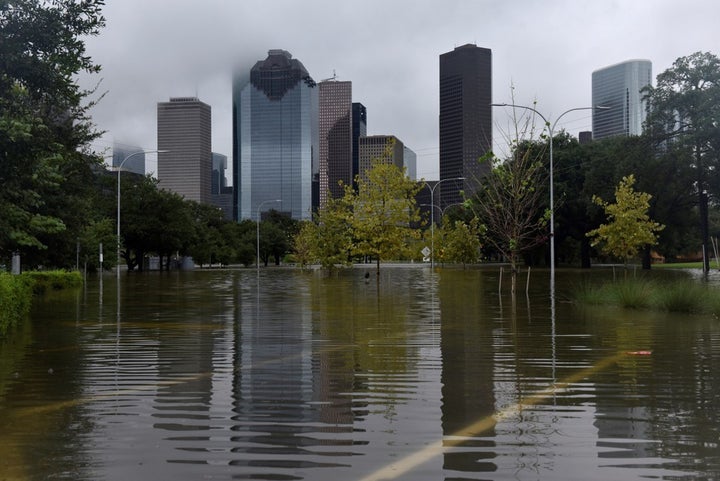
By Julie Beck
The devastating floodwaters from Hurricane Harvey will damage many human habitats, but after the flood recedes, the waterlogged city may become a more welcoming habitat for mosquitoes. And that means that residents already made vulnerable by the hurricane might also eventually be at increased risk for mosquito-borne diseases like West Nile virus and Zika.
West Nile virus has been endemic in Texas since 2002. In 2016, the state had 370 cases; so far in 2017, there have been 36 confirmed cases. Harris County, where Houston is located, has seen cases of West Nile in humans this year, and detected the virus in local mosquitoes.
Texas has also had 22 Zika cases in 2017, although local transmission has only been detected in Brownsville, a city on the Gulf Coast close to the Mexican border.
RELATED: What Makes a Storm Deadly?
The risk of infectious-disease outbreaks shortly after natural disasters is not as high as one might think, according to an overview published by researchers from the World Health Organization in Emerging Infectious Diseases. “Deaths associated with natural disasters, particularly rapid-onset disasters, are overwhelmingly due to blunt trauma, crush-related injuries, or drowning,” the article reads. “Deaths from communicable diseases after natural disasters are less common.” The greatest disease risk, according to these authors, comes from population displacement. If people are crowded in shelters with insufficient sanitation, that could create the conditions for disease to spread.
“If people are crowded in shelters with insufficient sanitation, that could create the conditions for disease to spread.”
With mosquito-borne illnesses specifically, it appears that there may be a delayed effect. In the short term, after a hurricane, there should actually be a lower risk of contracting these viruses, because the water likely washed away the existing breeding sites.
“But then over time, as the floodwaters recede, you’re left with pockets of water which are good for breeding both Culex mosquitoes and Aedes mosquitoes,” says Peter Hotez, the dean of the National School of Tropical Medicine at Baylor College of Medicine in Texas. Culex mosquitoes carry West Nile, as well as St. Louis encephalitis and Japanese encephalitis. Aedes aegypti are the primary carriers for Zika, as well as dengue, chikungunya, and yellow fever.
This is what happened after Hurricane Katrina in 2005. There was no increase in West Nile disease or St. Louis encephalitis in Louisiana or Mississippi that year. Researchers suspected this was because not only did flooding and winds destroy mosquitoes’ habitats, but evacuees ended up in areas less affected by those diseases.
However, the following year, researchers observed a more than twofold increase in cases of West Nile neuroinvasive disease — a more serious infection that can cause convulsions and even coma — in areas affected by Katrina. If Hurricane Harvey leaves a lot of standing water amongst the damage — standing water that stays for some time — Texas could see a similar delayed uptick in cases.
But it’s only August, and it’s possible the washed-away mosquitoes could still return this year. “The timing is kind of interesting,” Hotez says. “If we were at the end of arbovirus season, or we were headed well into the fall, then the effect would be beneficial because you’re going to wash the mosquitoes away and then basically, transmission season’s over. [But] we still have a lot of weeks of mosquito transmission season in Texas left.”
Robert Wright, the environmental health supervisor for Austin’s public health department, says that even inland in his city, he is seeing some water pooling in ditches and storm drains as a result of the hurricane. In areas of Texas where the flooding is less severe, there may still be areas of standing water that develop and attract mosquitoes. You’d expect to see “an increase in the mosquito populations in the weeks following the subsiding of the floods” in Houston, Wright says.
The WHO researchers also acknowledged this possibility. “Natural disasters do not usually cause an immediate increase in arboviral diseases,” they wrote. “However, if hurricanes strike early in transmission season, there could be a late increase in risk after vector and host populations are re-established.”
If populations do increase, “mostly those will be nuisance mosquitoes,” says Chris Van Deusen, a spokesman for the Texas Department of State Health Services. “However there is certainly a potential that we could see disease vectors in increasing numbers.” He notes that Harris County has a “very robust” mosquito-control program, and hopefully any disease carriers would be picked up in the course of normal mosquito surveillance.
Still, once Houston’s residents return to their homes, “it will be important for people as they start assessing things, just to take a few minutes to dump out that standing water in containers around their homes,” Van Deusen says, “to help suppress the population.”
Unfortunately, “the impact of floods on mosquito-borne viruses is still understudied,” Hotez says. Especially as climate change increases the risk of floods worldwide, it would be useful to understand just how all that water may enable mosquitoes — and the viruses they carry — to proliferate in the wake of a flood.
This story originally appeared on TheAtlantic.com.
More from The Atlantic: Why Do Women Bully Each Other at Work?, A Dinosaur So Well Preserved, It Looks Like a Statue